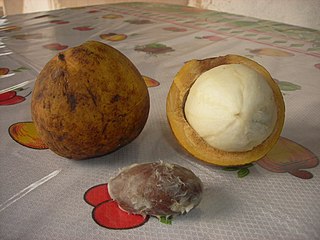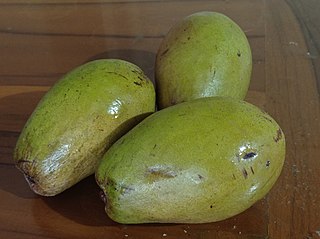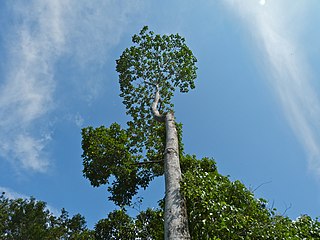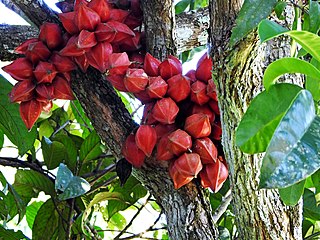
Platonia insignis, the sole species of the genus Platonia, is a tree of the family Clusiaceae native to South America in the humid forests of Brazil, Paraguay, parts of Colombia and northeast to Guyana; especially in Amazon Rainforest. Common names include bacuri, maniballi, naranjillo and bacurizeiro.

Mangifera caesia is a species of flowering plant in the cashew family, Anacardiaceae. Known in English as jack or white mango, among other names. It belongs to the same genus as the mango and is widely cultivated in areas of Indonesia, Malaysia, Singapore, Brunei, Papua New Guinea and the Philippines.

Mangifera pajang, commonly known as wild mango, is a species of tree in the family Anacardiaceae. It is endemic to Borneo, where it is known by the various native names: buahbambangan, buah mawang and buah embang.
Durio kinabaluensis, also known as mountain durian and (locally) as durian tapuloh, is a forest tree in the mallow family.

Couma utilis, called the milk tree, sorvinha, sorveira, sorva, and sorva-pequena, is a species of flowering plant in the subfamily Rauvolfioideae, native to the Orinoco and Amazon basins of South America. It is thought that C. utilis was on the verge of being domesticated by indigenous Amazonian peoples prior to the arrival of Europeans in the New World.
Durio crassipes, also known as durian hutan, is a species of flowering plant in the mallow family that is endemic to Borneo.
Mangifera griffithii is a species of flowering plant, a fruit tree in the mango family, that is native to Southeast Asia.
Mangifera torquenda is a species of flowering plant, a fruit tree in the mango family, that is native to Southeast Asia.
Willughbeia angustifolia is a species of flowering plant, a woody monoecious vine in the dogbane family, that is native to Southeast Asia.
Garcinia nitida, also known as kandis hutan, is a species of flowering plant, a dioecious understorey fruit tree in the mangosteen family, that is native to Southeast Asia.
Microcos crassifolia, also known locally as chanderai or bunsi, is a species of flowering plant, a fruit tree in the mallow family, that is endemic to Borneo.

Artocarpus lanceifolius, also known as keledang in Malay and more locally as timakon or kaliput, is a species of flowering plant, a fruit tree in the fig family, that is native to Southeast Asia.

Prainea limpato, also known as tampang susu in Malay and more locally as kesusu or empatak, is a species of flowering plant, a fruit tree in the fig family, that is native to Southeast Asia.

Artocarpus tamaran, also known as elephant jack in English, tarap tempunan in Malay, and more locally as timbangan, tamaran, entawa or wi yang, is a species of flowering plant, a fruit tree in the fig family, that is native to Southeast Asia.
Artocarpus teysmannii, also known as cempedak air in Malay and as tilap in Indonesia, is a species of flowering plant, a fruit tree in the fig family, that is native to Southeast Asia.
Sarcotheca diversifolia, also known as pupoi or belimbing bulat in Malay and more locally as tabarus, piang or belimbing hutan, is a species of flowering plant, a fruit tree in the wood sorrel family, that is native to Southeast Asia.

Baccaurea angulata, also known as belimbing hutan or belimbing darah in Malay and more locally as ucong or embaling, is a species of flowering plant, a fruit tree in the tampoi family, that is native to Southeast Asia.
Nephelium maingayi, also known as serait in Malay, mujau in Iban, and buah sungkit in Sabah and Brunei, is a species of flowering plant, a tropical forest fruit-tree in the rambutan family, that is native to Southeast Asia.
Nephelium papillatum is a species of flowering plant, a tropical forest fruit-tree in the rambutan family, that is endemic to Borneo.

Ficus grossularioides, the white-leaved fig, is a species of flowering plant that belongs to Moraceae, the fig or mulberry family, it is native to Southeast Asia.








